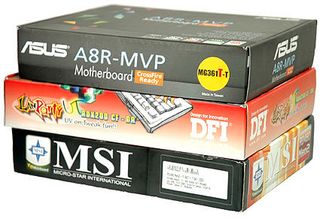Asus, DFI, MSI Give Mobos The Crossfire Treatment
Crossfire's NVIDIA SLI Challenge?

Although NVIDIA has a nine-month head start over ATI in the dual graphics chipset space and has the lead in both graphics performance and platform technology, the firm still continues to aggressively secure its place in the market. One good example is NVIDIA's acquisition of Taiwanese chipset maker ULi in December, which has added years to the company's already rich chipset-IP war chest. Moreover, NVIDIA can probably launch a two-card SLI system with four GPUs at any time the market warrants it.
NVIDIA's recently launched nForce4 SLI X16 chipsets for both AMD and Intel sockets offer two, full-featured x16 PCI Express ports. However, the PCI Express lanes are split between the Northbridge and Southbridge sections of the chipset, as opposed to allocating 32 lanes locally, which could potentially pose a performance penalty in the future. But, for today's applications, this design disadvantage will not be noticeable.
So where does that leave ATI? We thought a good place to start would involve an in-depth analysis and look at some of the first motherboards that are based on ATI's Radeon Xpress 200 Crossfire Edition chipset. What we can say from the outset is that if a good gaming experience is what you are after, the ATI Crossfire solution largely runs head to head with NVIDIA's SLI systems.
ATI's chipsets, however, do pose some interesting design challenges for motherboard makers, since ATI currently is unable to deliver a state-of-the-art Southbridge that can offer
Serial ATA II and Gigabit Ethernet. As a result, motherboard makers look for third party Southbridge alternatives in order to offer better overall value (e.g. Asus' A8R-MVP). This is particularly interesting because alternative Southbridges so far have only been used to reduce costs.
How Dual Graphics Works
Both ATI and NVIDIA deliver dual graphics solutions that effectively use two graphics chips in order to accelerate 3D processing. Future technology generations may easily use four or even more graphics chips to further increase performance. Just plug two suitable graphics cards (read on for details) into the x16 PCI Express graphics slots on your ATI Crossfire or NVIDIA SLI motherboard and connect them using the corresponding solutions. You then only have to enable dual graphics mode with the graphics driver control panel.
You may wonder why this is something people would want to have, given that many games already exceed performance figures of 100 frames per seconds (FPS). There are, however, many options that can be enabled in order to increase the visual experience. Antialiasing helps to smooth edges, for example, or anisotropic filtering can reduce aliasing effects while producing less blur. Finally, some visual effects require each and every image to be run through the pixel shaders multiple times, which can have quite an impact on performance. Future 3D models (e.g. DirectX 10) will allow for fully programmable shaders, which will enable a graphics subsystem (single-, dual- or multi-GPU graphics) to do more calculations than ever before.
Stay On the Cutting Edge: Get the Tom's Hardware Newsletter
Get Tom's Hardware's best news and in-depth reviews, straight to your inbox.
ATI ideally requires one so-called Crossfire master graphics card (these have not yet been available for the X1000 series) that is paired with any X1000 series model that at least matches the chip model number (e.g. Radeon X1800XT Master plus a regular Radeon X1800XT). The Crossfire Master card features an additional piece of silicon that takes care of the final image composition, while the workload is shared between two (or more) graphics processing units.

Microsoft prepares DirectX to support neural rendering for AI-powered graphics — a key feature of the update will be Cooperative Vector support

Intel i9-14900KF overclocker clinches CPU frequency world record at 9.12 GHz — Wytiwx joins Elmor as the only person to push a CPU past 9 GHz

Maker builds a Raspberry Pi 5 powered stereoscopic 3D video camera
Most Popular

